-

中班语言课件教案:恐龙妈妈藏蛋
2. 能看图讲述故事,体验编构故事结尾的乐趣。材料准备: 布置场景(草丛树洞沙滩鹅卵石泥土)图片挂图恐龙蛋若干指导要点: 1. 以玩藏蛋的游戏。体验藏的方法,知道怎样藏不被人发现。师“今天老师带来了几个东西。你们看看是什么?”(鸡蛋)“我们一块来玩藏蛋的游戏“一些小朋友来找蛋。”“你们要看那些地方藏蛋,不容易被发现? ”师提问:“你把蛋藏哪了?你为什么要这样藏?”2. 教师出示图一图二。引导幼儿围绕恐龙妈妈怎样藏蛋进行看图讲述。并引导幼儿大胆猜测恐龙妈妈藏蛋的办法。
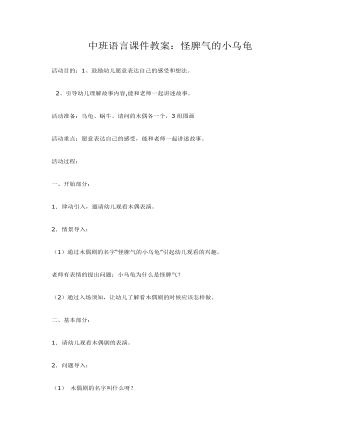
中班语言课件教案:怪脾气的小乌龟
2、引导幼儿理解故事内容,能和老师一起讲述故事。活动准备:乌龟、蜗牛、请问的木偶各一个,3组图画活动重点:愿意表达自己的感受,能和老师一起讲述故事。活动过程:一、开始部分:1. 律动引入,邀请幼儿观看木偶表演。2. 情景导入:(1)通过木偶剧的名字“怪脾气的小乌龟”引起幼儿观看的兴趣。老师有表情的提出问题:小乌龟为什么是怪脾气?(2)通过入场须知,让幼儿了解看木偶剧的时候应该怎样做。

中班语言教案:趣味识动字—跳、爬、吹、打
2、激发幼儿学习兴趣,积极参与游戏活动。准备:多媒体课件(跳、爬、吹、打四个字);骰子一个;打、吹的物品;会爬动物的头饰(如虫、蜗牛);圈; 过程:一:看动画识字上次我们去动物园,看到了很多动物,还看到了海狮和大象为我们表演的节目,小朋友,觉得怎么样啊?有些小动物今天来到幼儿园,还要为我们表演节目,我们来看看它们是谁。 A:(1)图上是谁?它在干什么?我们来学学小公鸡吹喇叭吧!(2)小公鸡还带来一个字宝宝,认识一下吧,这是“吹”宝宝,请“吹”宝宝也表演一个节目。(3)还有什么东西也可以吹呢?是用什么吹的?“吹”宝宝的身上有什么?
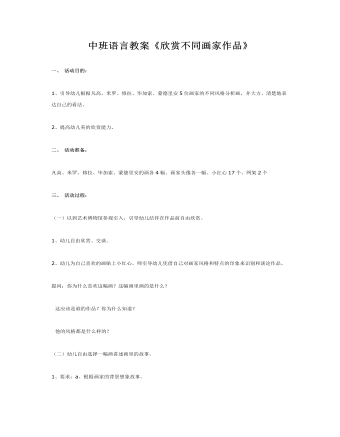
中班语言教案《欣赏不同画家作品》
2、提高幼儿美的欣赏能力。二、活动准备:凡高、米罗、修拉、毕加索、蒙德里安的画各4幅、画家头像各一幅、小红心17个、网架2个三、活动过程:(一)以到艺术博物馆参观引入,引导幼儿结伴在作品前自由欣赏。1、幼儿自由欣赏、交谈。2、幼儿为自己喜欢的画贴上小红心。师引导幼儿凭借自己对画家风格和特点的印象来
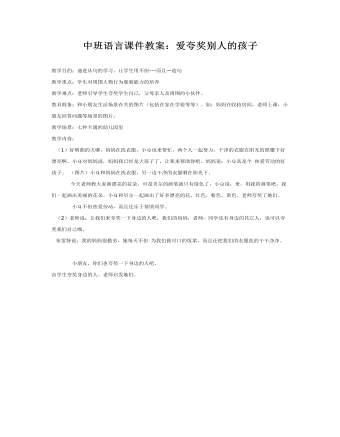
中班语言课件教案:爱夸奖别人的孩子
教学难点:老师引导学生夸奖学生自己,父母亲人及周围的小伙伴。 教具准备:和小朋友生活场景有关的图片(包括在家在学校等等)。如:妈妈在收拾房间,老师上课,小朋友回答问题等场景的图片, 教学场景:七秒卡通的幼儿园里 教学内容: (1)好晴朗的天哪,妈妈在洗衣服,小Q也来帮忙,两个人一起努力,干净的衣服在阳光的照耀下好漂亮啊。小Q对妈妈说,妈妈我已经是大孩子了,让我来帮助你吧。妈妈说:小Q真是个热爱劳动的好孩子。(图片)小Q和妈妈在洗衣服,另一边干净的衣服晒在阳光下。
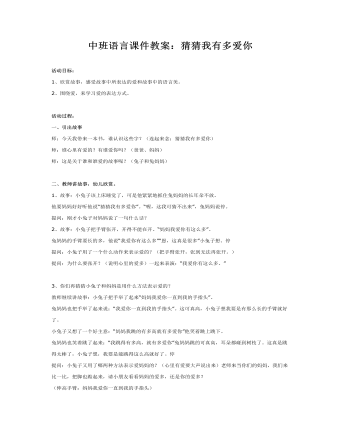
中班语言课件教案:猜猜我有多爱你
活动过程:一、引出故事师:今天我带来一本书,谁认识这些字?(连起来念:猜猜我有多爱你)师:谁心里有爱的?有谁爱你吗?(爸爸、妈妈)师:这是关于谁和谁爱的故事呢?(兔子和兔妈妈) 二、教师讲故事,幼儿欣赏。1、故事:小兔子该上床睡觉了,可是他紧紧地抓住兔妈妈的长耳朵不放。他要妈妈好好听他说“猜猜我有多爱你”。“喔,这我可猜不出来”,兔妈妈说停。提问:刚才小兔子对妈妈说了一句什么话?2、故事:小兔子把手臂张开,开得不能在开。“妈妈我爱你有这么多”。兔妈妈的手臂要长的多,他说“我爱你有这么多”“恩,这真是很多”小兔子想。停提问:小兔子用了一个什么动作来表示爱的?(把手臂张开,张到无法再张开。)提问:为什么要张开?(说明心里的爱多)一起来表演:“我爱你有这么多。”
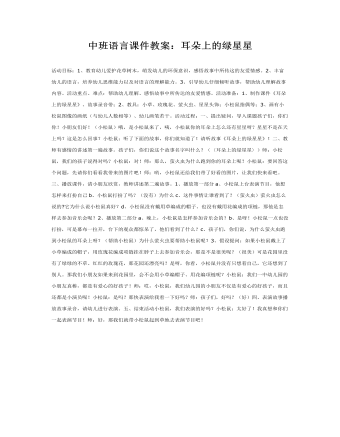
中班语言课件教案:耳朵上的绿星星
活动准备:1、制作课件《耳朵上的绿星星》、故事录音带;2、教具:小草、玫瑰花、萤火虫、星星头饰;小松鼠指偶等;3、画有小松鼠图像的画纸(与幼儿人数相等)、幼儿画笔若干。活动过程:一、提出疑问,导入课题孩子们,你们你!小朋友们好!(小松鼠)哦,是小松鼠来了,咦,小松鼠你的耳朵上怎么还有星星呀?星星不是在天上吗?这是怎么回事?小松鼠:听了下面的故事,你们就知道了!请听故事《耳朵上的绿星星》!二、教师有感情的讲述第一遍故事。孩子们,你们说这个故事名字叫什么?(〈耳朵上的绿星星〉)师:小松鼠,我们的孩子说得对吗?小松鼠:对!师:那么,萤火虫为什么跑到你的耳朵上呢?小松鼠:要回答这个问题,先请你们看看我带来的图片吧!师:哟,小松鼠还给我们带了好看的图片,让我们快来看吧。三、播放课件,请小朋友欣赏,教师讲述第二遍故事。1、播放第一部分a、小松鼠上台表演节目,他想怎样来打扮自己b、小松鼠打扮了吗?(没有)为什么c、这件事情让谁看到了?(萤火虫)萤火虫怎么说的?它为什么说小松鼠真好?d、小松鼠没有戴用草编成的帽子、也没有戴用花编成的项链,那他是怎样去参加音乐会呢?2、播放第二部分a、晚上,小松鼠是怎样参加音乐会的?b、是呀!小松鼠一点也没打扮,可是幕布一拉开,台下的观众都惊呆了,他们看到了什么?
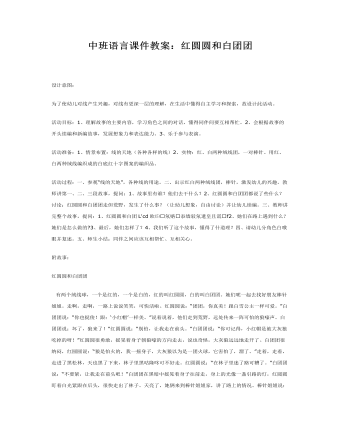
中班语言课件教案:红圆圆和白团团
活动准备:1、情景布置:线的天地(各种各样的线)2、实物:红、白两种绒线团,一对棒针。用红、白两种绒线编织成的白底红十字图案的编织品。活动过程:一、参观“线的天地”,各种线的用途。二、出示红白两种绒线团,棒针,激发幼儿的兴趣。教师讲第一、二、三段故事,提问:1、故事里有谁?他们去干什么?2、红圆圆和白团团都说了些什么?讨论:红圆圆和白团团走但荒野,发生了什么事?(让幼儿想象,自由讨论)并让幼儿续编。三、教师讲完整个故事,提问:1、红圆圆和白团L'cd欧⑸氖赂忝墙驳氖遣皇且谎f2、她们在路上遇到什么?她们是怎么做的?3、最后,她们怎样了?4、我们听了这个故事,懂得了什道理?四、请幼儿分角色白哦眼并复述。五、师生小结:同伴之间应该互相帮忙、互相关心。
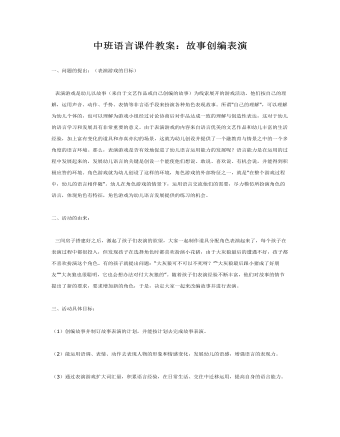
中班语言课件教案:故事创编表演
二、活动的由来: 三间房子搭建好之后,激起了孩子们表演的欲望,大家一起制作道具分配角色表演起来了,每个孩子在表演过程中都很投入,但发现孩子在选择角色时都喜欢扮演小花猪,由于大灰狼最后的遭遇不好,孩子都不喜欢扮演这个角色。有的孩子就提出问题:“大灰狼可不可以不死呀?”“大灰狼最后跟小猪成了好朋友”“大灰狼也很聪明,它也会想办法对付大灰狼的”。随着孩子们表演经验不断丰富,他们对故事的情节提出了新的要求,要求增加新的角色,于是,决定大家一起来改编故事并进行表演。三、活动具体目标:(1)创编故事并制订故事表演的计划,并能按计划去完成故事表演。(2)能运用语调、表情、动作去表现人物的形象和情感变化,发展幼儿的语感,增强语言的表现力。(3)通过表演游戏扩大词汇量,积累语言经验,在日常生活、交往中迁移运用,提高自身的语言能力。(4)培养幼儿自信、勇敢、大方的个性,能积极主动与人交谈、协商、合作与交往。
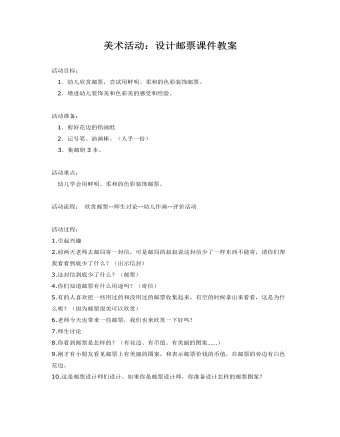
美术活动:设计邮票课件教案
2.增进幼儿装饰美和色彩美的感受和经验。 活动准备:1.剪好花边的铅画纸2.记号笔、油画棒。(人手一份) 3.集邮册3本。活动重点: 幼儿学会用鲜明、柔和的色彩装饰邮票。活动流程:欣赏邮票--师生讨论--幼儿作画--评价活动
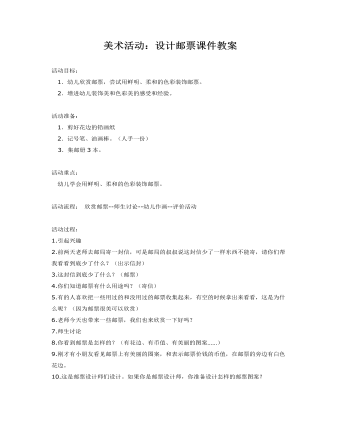
美术活动:设计邮票课件教案
2.增进幼儿装饰美和色彩美的感受和经验。 活动准备:1.剪好花边的铅画纸2.记号笔、油画棒。(人手一份) 3.集邮册3本。活动重点: 幼儿学会用鲜明、柔和的色彩装饰邮票。活动流程:欣赏邮票--师生讨论--幼儿作画--评价活动
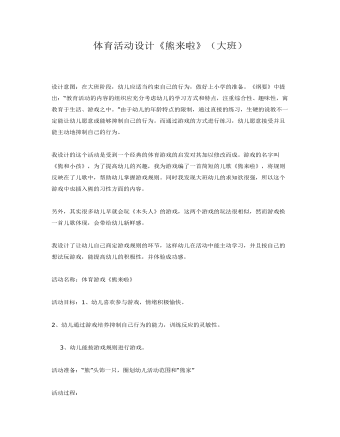
体育活动设计《熊来啦》课件教案
我设计的这个活动是受到一个经典的体育游戏的启发对其加以修改而成。游戏的名字叫《熊和小孩》,为了提高幼儿的兴趣,我为游戏编了一首简短的儿歌《熊来啦》,将规则反映在了儿歌中,帮助幼儿掌握游戏规则。同时我发现大班幼儿的求知欲很强,所以这个游戏中也插入熊的习性方面的内容。另外,其实很多幼儿早就会玩《木头人》的游戏,这两个游戏的玩法很相似,然而游戏换一首儿歌体现,会带给幼儿新鲜感。我设计了让幼儿自己商定游戏规则的环节,这样幼儿在活动中能主动学习,并且按自己的想法玩游戏,能提高幼儿的积极性,并体验成功感。活动名称:体育游戏《熊来啦》活动目标:1、幼儿喜欢参与游戏,情绪积极愉快。2、幼儿通过游戏培养抑制自己行为的能力,训练反应的灵敏性。 3、幼儿能按游戏规则进行游戏。活动准备:“熊”头饰一只,圈划幼儿活动范围和“熊家”活动过程:1、导入活动。 教师:“如果你突然遇到一头大狗熊,你该怎么样,它才不会吃你?”幼儿讨论提出意见。

新人教版高中英语选修2Unit 2 Bridging Cultures-Discovering useful structures教学设计
The grammar of this unit is designed to review noun clauses. Sentences that use nouns in a sentence are called noun clauses. Nominal clauses can act as subject, object, predicate, appositive and other components in compound sentences. According to the above-mentioned different grammatical functions, nominal clauses are divided into subject clause, object clause, predicate clause and appositive clause. In this unit, we will review the three kinds of nominal clauses. Appositive clauses are not required to be mastered in the optional compulsory stage, so they are not involved.1. Guide the students to judge the compound sentences and determine the composition of the clauses in the sentence.2. Instruct students to try to learn grammar by generalizing grammar rules, controlling written practice, and semi-open oral output.3. Inspire the students to systematize the function and usage of noun clause1.Instruct students to try to learn grammar by generalizing grammar rules, controlling written practice, and semi-open oral output.2.Inspire the students to systematize the function and usage of noun clauseStep1: The teacher ask studetns to find out more nominal clauses from the reading passage and udnerline the nominal clauses.

新人教版高中英语选修2Unit 3 Food and Culture-Reading and thinking教学设计
The discourse explores the link between food and culture from a foreign’s perspective and it records some authentic Chinese food and illustrates the cultural meaning, gerography features and historic tradition that the food reflects. It is aimed to lead students to understand and think about the connection between food and culture. While teaching, the teacher should instruct students to find out the writing order and the writer’s experieces and feelings towards Chinese food and culture.1.Guide the students to read the text, sort out the information and dig out the topic.2.Understand the cultural connotation, regional characteristics and historical tradition of Chinese cuisine3.Understand and explore the relationship between food and people's personality4.Guide the students to use the cohesive words in the text5.Lead students to accurately grasp the real meaning of the information and improve the overall understanding ability by understanding the implied meaning behind the text.1. Enable the Ss to understand the structure and the writing style of the passage well.2. Lead the Ss to understand and think further about the connection between food and geography and local character traits.Step1: Prediction before reading. Before you read, look at the title, and the picture. What do you think this article is about?keys:It is about various culture and cuisine about a place or some countries.

新人教版高中英语必修3Unit 1 Festivals and Celebrations-Reading and Thinking教学设计
The topic of this part is “Discover the reasons for festivals and celebrations.The Listening & Speaking & Talking part aims at talking about the experiences and feelings or emotions about the festivals and celebrations. This section aims at detecting the reason why the people celebrate the festivals, the time, the places, the types and the way of celebrations. It also explains why some traditions in the old celebrations are disappearing, like the firecrackers in the big cities and some new things are appearing like the prosperity of business or commerce. 1. Students can talk about what festivals they know and the reasons and the way of celebrating them.2. Students should learn the reading skills such as the headline and get the topic sentences, the structures of articles.3. Students can understand the past, the present situation of some festival around the world and why there are some changes about them. 4. Students can have the international awareness about the festivals.1. Students should learn the reading skills such as the headline and get the topic sentences, the structures of articles.2. Students can understand the past, the present situation of some festival around the world and why there are some changes about them.Step 1 Lead in---Small talkWhat festival do you like best ? Why ?I like the Spring Festivals because I can set off the fireworks, receive the lucky money and enjoy the Gala with my families.Step 2 Before reading---Pair workWhy do people celebrate different festivals ?The Spring Festivals is to celebrate the end of winter and the coming of spring and new life.The Mid-autumn Day is to celebrate the harvest and admire the moon.

新人教版高中英语必修3Unit 1 Festivals and Celebrations-Listening &Speaking&Talking教学设计
The theme of this section is “Talk about festival activities and festival experiences”.Festival and holiday is a relaxing and interesting topic for students. This part talks about the topic from the daily life of students’. In the part A ---Listening and Speaking, there are three conversations among different speakers from three countries(Japan, Rio and China), where the speakers are participating in or going to participate in the festivals and celebrations. So listening for the relationship among them is a fundamental task. Actually, with the globalization and more international communication, it is normal for Chinese or foreigners to witness different festivals and celebrations in or out of China. In the Conversation 1, a foreign reporter is interviewing a Japanese young girl who just had participated in the ceremony of the Coming-of-Age Day on the street and asking her feeling about the ceremony and the afterwards activities. Conversation 2, Chinese girl Li Mei is witnessing the Rio Carnival for the first time, and her friend Carla gives her some advice on the costumes which enables her to match with the carnival to have a good time. Conversation 3, a Chinese guide is showing a group of foreign visitors around the Lantern Festival and introducing the customs of the festival to them. The three conversations have a strong vitality and insert the festival and cultural elements from different countries. So perceiving the festivals and cultures from different countries is the second task. At the same time, the scripts also insert the targeted grammar --- v-ing as attributive and predicative, which students can perceive and experience in a real context and make a road for the further study. That is the third task. In the Part B--- Listening and Talking, the theme is “Talk about festival experience”, which is the common topic in our daily conversations. During the conversation, Song Lin, a Chinese student, asked Canadian friend Max about how to spend Christmas. In the conversation, Song Lin talked about experience and the feelings during the Chinese Spring Festival, during which there are not only some enjoyable things but some unpleasant things. After the listening, perhaps students find there are some similarities between Christmas and the Chinese Spring Festival as there are some differences in the origins and celebrations. For example, people always visit friends and relatives, decorate their houses, have a big dinner together, chat and give presents to each other.

新人教版高中英语必修3Unit 2 Morals and Virtues-Discovering Useful Structure教学设计
1. 表示时间。Hearing these stories, I’m skeptical about the place. = When I heard these stories. . . 2. 表示原因。Not knowing his address, I can’t send this book to him. = Because/Since/As I don’t know his address. . . 3. 表示结果。His father died, leaving him a lot of money. =. . . and left him a lot of money4. 表示条件。Going straight down the road, you will find the department store. = If you go straight down the road. . . 5. 表示让步。Being tired, they went on working. =Although they were tired. . . 6. 表示行为方式、伴随情况或补充说明。He lay on the grass, staring at the sky for a long time. =. . . and stared at the sky for a long time注意:非谓语动词作状语时, 如所提供的动词不能和句子中的主语保持一致, 动词-ing形式必须有自己的逻辑主语, 通常由名词或代词来担任, 这就是独立主格结构。The last bus having gone, we had to walk home. (having gone的逻辑主语是the last bus, 而不是we)Weather permitting, the football match will be played on Friday. (permitting的逻辑主语是time, 而不是the football match)Step 7 Practice1. ________(study) hard, you are sure to get first prize. 2. People use plastic in their daily life, _______(leave) large amounts of waste. 3. ________(work) hard at your lessons, you are to succeed. 4. The old man, ____________(work) abroad for twenty years, is on the way back to his motherland. 5. ______________(finish) his homework, he was playing on the playground. Answers: 1. Studying 2. leaving 3. Working 4.having worked 5. Having finishedStep 8 HomeworkFinish the homework on Page 22.

新人教版高中英语必修3Unit 2 Morals and Virtues-Reading and Thinking教学设计
The topic of this part is “Learn to make choices in life”.The Listening & Speaking & Talking part aims at the moral dilemmas, and this part is about making choices in life. The heroin is Lin Qiaozhi, a famous medical scientist, made a great contribution to our country’s medical care. Most importantly, her life experience can inspire our students whether in studying or the development of career. she had moral dilemmas and life choices, which are similar to the students who will step into society. Besides, Lin has quite good virtues like kindness, self-improvement, insistence, job-loving , generosity and responsibility, which is worth being learned.Concretely, this article is a biography about Lin Qiaozhi. The article tells her whole life according the timeline, among which the life choices is emphasized. For example, whether married or chased her dream, returned home or stayed abroad, family or public, her choices all reflected her faith, spirit, responsibility and devotion.1. Fast reading to get the detailed information about Lin Qiaozhi; careful reading to do the deductive information.2. Learn the reading skills--deductive judgement according the context.3. Study the structure features and language features. 4. Communicate about Lin’s life choices and reflect their own life choices.1. Learn the reading skills--deductive judgement according the context.2. Study the structure features and language features.3. Communicate about Lin’s life choices and reflect their own life choices.Step 1 Lead in---Small talkWhat are some important life choices?Importance choices: university study, jobs and marriage partners. Because they can determine our future.

新人教版高中英语必修3Unit 3 Diverse Cultures-Discovering Useful Structure教学设计
Step 4 PracticeRead the conversation. Find out which words have been left out.Justin: Linlin, I’m going to Guizhou Province next month. I’m super excited! Any recommendations for places to visit?Linlin: Wow, cool! Guizhou is a province with a lot of cultural diversity. Places to visit...well, definitely the Huangguoshu Waterfall first.Justin: What’s special about the waterfall?Linlin: Well, have you ever heard of the Chinese novel Journey to the West ?Justin: Yes, I have. Why ?Linlin: In the back of the waterfall, you will find a cave, which is the home of the Monkey King.Justin: Really? Cool! I’ll definitely check it out.Linlin:And I strongly recommend the ethnic minority villages. You’ll find Chinese culture is much more diverse than you thought.Justin:Sounds great, thanks.Answers:Justin: Linlin, I’m going to Guizhou Province next month. I’m super excited! Do you have any recommendations for places to visit?Linlin: Wow, that’s cool! Guizhou is a province with a lot of cultural diversity. What are some places to visit in Guizhou ? Well, definitely the Huangguoshu Waterfall is the first place to visit in Guizhou Province.Justin: What’s special about the waterfall?Linlin: Well, have you ever heard of the Chinese novel Journey to the West ?Justin: Yes, I have heard of the Chinese novel Journey to the West . Why do you ask if I have heard of the Chinese novel Journey to the West?Linlin: In the back of the waterfall, you will find a cave, which is the home of the Monkey King from Journey to the West.Justin: That’s really true? It’s Cool! I’ll definitely check it out.Linlin:And I strongly recommend the ethnic minority villages on your trip to Guizhou Province. You’ll find Chinese culture is much more diverse than you thought it was.Justin:This all sounds great, thanks.

新人教版高中英语必修3Unit 3 Diverse Cultures-Reading for Writing教学设计
The topic of this part is “Describe a place with distinctive cultural identity”.This section focuses on Chinese culture by introducing Chinatown, whose purpose is to show the relationship between the Chinese culture and American culture. The Chinese culture in Chinatown is an important part of American culture. Chinatown is an important window of spreading Chinese culture and the spirit homeland of oversea Chinese, where foreigners can experience Chinese culture by themselves.Concretely, the title is “Welcome to Chinatown!”, from which we can know that the article aims at introducing Chinatown. The author used the “Introduction--Body Paragraph--Conclusion” to describe the people, language, architecture, business, famous food and drinks and people’s activities, which can be a centre for Chinese culture and shows its unique charm.1. Read quickly to get main idea; read carefully to get the detailed information.2. Learn the characteristics of writing and language.3. Learn to introduce your own town according to the text.4. Learn to correct others’ writing.1. Learn the characteristics of writing and language.2. Learn to introduce your own town according to the text.Step 1 Lead in ---Small talkIn the reading part, we mentioned the Chinatown of San Francisco. How much do you know about Chinatown of San Francisco ?Chinatown is a main living place for Chinese immigrants, where you can see many Chinese-style buildings, costumes, operas, restaurants, music and even hear Chinese.Step 2 Before reading ---Predict the contentWhat is the writer’s purpose of writing this text ? How do you know ?From the title(Welcome to Chinatown) and some key words from the text(tourist, visit, visitors, experience), we can know the purpose of the text is to introduce Chinatown and show the relationship between Chinese culture and American culture.